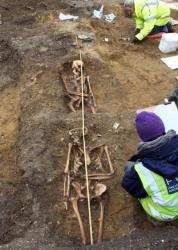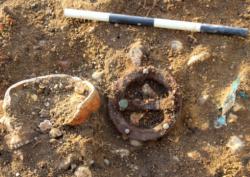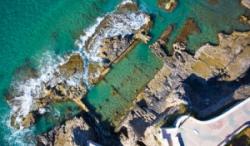INSTITUT SUPERIEUR D'ANTHROPOLOGIE
INSTITUTE OF ANTHROPOLOGY
ONLINE COURSES / COURS A DISTANCE
SPRING TERM : APRIL 2014
REGISTER NOW
ALGERIE –  Sour El Ghozlane - La ville de Sour El Ghozlane, située à une quarantaine de kilomètres au sud de Bouira, vient d'ajouter un autre site archéologique de valeur à son riche patrimoine historique issu des civilisations amazighe et romaine. En plus des ruines du temple romain, le tombeau de Takfarinas à El Hakimia ainsi la muraille et les portes de Sour El Ghozlane, qui constituaient, jusqu'à présent, les sites archéologiques les plus connus, un nouveau site archéologique, datant de l'époque romaine, a été découvert, dimanche dernier, en plein centre-ville, par un citoyen, qui accomplissait des travaux de terrassement pour une nouvelle construction individuelle. Il s'agit de ruines d’une maison romaine et des restes d’un long tunnel datant de la même époque, selon les premières informations recueillies, auprès d'habitants de la localité. Cette découverte n'est pas la première du genre, et les riverains de Sour El Ghozlane sont habitués à des trouvailles fortuites, faites au cours de travaux de construction, en raison de son histoire marqué par la succession des civilisations Berbère, Phénicienne ensuite Romaine et son riche patrimoine. Sur le site de la découverte, l’on pourra remarquer des remparts encore debout, des colonnes ornées avec des mosaïques. Au centre même des ruines, des silos, des tombeaux taillés dans le roc, des pierres sculptées, un long tunnel souterrain et d’autres inscriptions révèlent l'emplacement d'une ville romaine. Une équipe d'archéologues, relevant de la direction de la culture de la wilaya de Bouira, s'est déplacée, sur place, afin de vérifier et dater le site découvert. Les objets trouvés seront transférés vers le musée d’histoire de Bouira, afin de les préserver de toute dégradation et vol. Selon des sources locales, un dossier sera adressé, prochainement, au ministère de la Culture en vue de la prise en charge de ce site.
Sour El Ghozlane - La ville de Sour El Ghozlane, située à une quarantaine de kilomètres au sud de Bouira, vient d'ajouter un autre site archéologique de valeur à son riche patrimoine historique issu des civilisations amazighe et romaine. En plus des ruines du temple romain, le tombeau de Takfarinas à El Hakimia ainsi la muraille et les portes de Sour El Ghozlane, qui constituaient, jusqu'à présent, les sites archéologiques les plus connus, un nouveau site archéologique, datant de l'époque romaine, a été découvert, dimanche dernier, en plein centre-ville, par un citoyen, qui accomplissait des travaux de terrassement pour une nouvelle construction individuelle. Il s'agit de ruines d’une maison romaine et des restes d’un long tunnel datant de la même époque, selon les premières informations recueillies, auprès d'habitants de la localité. Cette découverte n'est pas la première du genre, et les riverains de Sour El Ghozlane sont habitués à des trouvailles fortuites, faites au cours de travaux de construction, en raison de son histoire marqué par la succession des civilisations Berbère, Phénicienne ensuite Romaine et son riche patrimoine. Sur le site de la découverte, l’on pourra remarquer des remparts encore debout, des colonnes ornées avec des mosaïques. Au centre même des ruines, des silos, des tombeaux taillés dans le roc, des pierres sculptées, un long tunnel souterrain et d’autres inscriptions révèlent l'emplacement d'une ville romaine. Une équipe d'archéologues, relevant de la direction de la culture de la wilaya de Bouira, s'est déplacée, sur place, afin de vérifier et dater le site découvert. Les objets trouvés seront transférés vers le musée d’histoire de Bouira, afin de les préserver de toute dégradation et vol. Selon des sources locales, un dossier sera adressé, prochainement, au ministère de la Culture en vue de la prise en charge de ce site.
http://www.depechedekabylie.com/cuture/134922-nouvelle-decouverte-archeologique.html
ROYAUME UNI – 
 Haddenham - At the start of the month, Pre-Construct Archaeology was invited to excavate a small site in the car park of the Three Kings pub, at the heart of the village, before developers moved on and began work on a new house. And, despite the dig taking place over a small site, the dig turned up a wealth of finds, including nine burials and plenty of grave goods in what experts believe was a Saxon burial ground. The bodies discovered are believed to date back to the early Saxon period - around the 6th century AD - and included both men and women, young and old. Archaeologists believe the people were pagan but, interesting, the burials were aligned east to west, a typically Christian trait. The burials included a man found lying on a decorative shield, with a knife and a spear also discovered. A beaded necklace was found around the neck and upper torso of a woman, who was also buried with a belt made with copper and iron fittings. It is not the first time skeletons have been found at the pub, back in 1990, the remains of three people were found along with a shield and a dagger.
Haddenham - At the start of the month, Pre-Construct Archaeology was invited to excavate a small site in the car park of the Three Kings pub, at the heart of the village, before developers moved on and began work on a new house. And, despite the dig taking place over a small site, the dig turned up a wealth of finds, including nine burials and plenty of grave goods in what experts believe was a Saxon burial ground. The bodies discovered are believed to date back to the early Saxon period - around the 6th century AD - and included both men and women, young and old. Archaeologists believe the people were pagan but, interesting, the burials were aligned east to west, a typically Christian trait. The burials included a man found lying on a decorative shield, with a knife and a spear also discovered. A beaded necklace was found around the neck and upper torso of a woman, who was also buried with a belt made with copper and iron fittings. It is not the first time skeletons have been found at the pub, back in 1990, the remains of three people were found along with a shield and a dagger.
http://www.cambstimes.co.uk/news/gallery_village_excavation_turns_up_a_wealth_of_finds_dating_back_1_400_years_1_3342744
CHINE - Shimao - Chinese archaeologists have discovered altar relics at the ruins of a neolithic city, which indicate religious culture at that time. An initial survey showed the eight-meter-high altar had a three-tiered structure with a stone base 90 meters long. Jade relics and pits for offerings as deep as three meters were found nearby, said Sun Zhouyong, deputy head of the Shaanxi Provincial Institute of Archaeology on Thursday. Excavation has not started at the altar, outside the walls of the Shimao Ruins in Shenmu County. Archaeologists have collected some jade for further research. They excavated over 80 human skulls last year. Shimao Ruins were discovered in 1976 , but archaeologists did conduct a a thorough survey until last year, which led to more discoveries. The city was found to have inner and outer structures, and the walls surrounding the outer city extend over four square kilometers. The city was built about 4,300 years ago and abandoned roughly 300 years later during the Xia Dynasty (2100-1600 BC), the first dynasty in China described in historical chronicles.
http://english.cri.cn/6909/2014/02/20/2702s813914.htm
ESPAGNE –  Baños de la Reina - Calpe, Javea and Campello each have shoreline archaeological remains known as the Queen’s Baths (Baños de la Reina). An exhibition that opened recently at Calpe’s Ajuntament Vell focuses on the three sites and their background, with particular attention to Campello. The Campello complex L’Illeta de la Reina covers a 4,000 square metre site and was first inhabited during the Bronze Age. It was used inhabited by Iberians, Romans and Moors. The Illeta was originally a small promontory that later became separated from the mainland by erosion. In 1943 it was joined once more to the mainland although this destroyed valuable remains. As in Calpe and Javea, the Illeta incorporates fish farms built by the Romans although these were believed by later generations to have been the private baths of a Moorish queen. The exhibition, which continues until March 30, has been organised by Alicante city’s Archaeological Museum (MARQ) in collaboration with Calpe’s Museo de Historia. It continues until March 30.
Baños de la Reina - Calpe, Javea and Campello each have shoreline archaeological remains known as the Queen’s Baths (Baños de la Reina). An exhibition that opened recently at Calpe’s Ajuntament Vell focuses on the three sites and their background, with particular attention to Campello. The Campello complex L’Illeta de la Reina covers a 4,000 square metre site and was first inhabited during the Bronze Age. It was used inhabited by Iberians, Romans and Moors. The Illeta was originally a small promontory that later became separated from the mainland by erosion. In 1943 it was joined once more to the mainland although this destroyed valuable remains. As in Calpe and Javea, the Illeta incorporates fish farms built by the Romans although these were believed by later generations to have been the private baths of a Moorish queen. The exhibition, which continues until March 30, has been organised by Alicante city’s Archaeological Museum (MARQ) in collaboration with Calpe’s Museo de Historia. It continues until March 30.
https://www.euroweeklynews.com/news/costa-blanca-north/item/118872?
SCANDINAVIE –  On a survécu à la fin du monde prédite par les Mayas. Mais qu'en est-il de celle prévue par les Vikings ? Le 22 février est le jour du "Ragnarok", l'ultime combat auxquels doivent se livrer les dieux vikings, jusqu'à l'Apocalyspe. Nommée "Ragnarok" (Crépuscule des dieux), la fin du monde viking consiste en une dernière bataille entre les dieux créateurs. Selon la légende, le son de la corne appellera les fils du dieu Odin et les héros de la bataille, avant que ceux-ci ne soient tués par Fenrir, un loup gigantesque. Une autre partie de la légende prétend que Jormungand, un immense serpent de mer, doit se libérer de sa queue et se lever de l'océan. Certains adeptes de cette mythologie ont affirmé que cela s'était déjà réalisé l'an dernier, lorsque deux poissons géants se sont échoués sur la côte californienne.
On a survécu à la fin du monde prédite par les Mayas. Mais qu'en est-il de celle prévue par les Vikings ? Le 22 février est le jour du "Ragnarok", l'ultime combat auxquels doivent se livrer les dieux vikings, jusqu'à l'Apocalyspe. Nommée "Ragnarok" (Crépuscule des dieux), la fin du monde viking consiste en une dernière bataille entre les dieux créateurs. Selon la légende, le son de la corne appellera les fils du dieu Odin et les héros de la bataille, avant que ceux-ci ne soient tués par Fenrir, un loup gigantesque. Une autre partie de la légende prétend que Jormungand, un immense serpent de mer, doit se libérer de sa queue et se lever de l'océan. Certains adeptes de cette mythologie ont affirmé que cela s'était déjà réalisé l'an dernier, lorsque deux poissons géants se sont échoués sur la côte californienne.
http://www.francetvinfo.fr/monde/europe/selon-la-mythologie-viking-la-fin-du-monde-c-est-samedi_534493.html#xtor=AL-79-%5Barticle%5D